Airborne Lidar Refines Georeferencing Austro-Hungarian Maps from the First and Second Military Surveys
Abstract
1. Introduction
2. Materials and Methods
2.1. Military Mapping
2.2. Data Used for Georeferencing
2.2.1. Historical Orthophoto Mosaic of Slovakia
2.2.2. Orthophoto Mosaic of the Slovak Republic
2.2.3. Special Maps 1:75,000
2.2.4. Military Topographic Mapping 1:25,000
2.2.5. Military Topographic Mapping 1:10,000
2.2.6. Distance Map of Hungary 1:75,000
2.2.7. Base Map of the Slovak Republic 1:10,000
2.2.8. Airborne Laser Scanning Data (ALS)
2.2.9. Specialised Visualisation of ALS Data
2.3. Areas of Interest
2.4. Identifying Control Points and Data Processing
2.5. Georeferencing of Areas of Interest and Assessing the Accuracy of Georeferencing Existing Maps
2.6. Testing the Accuracy of Georeferenced Maps Using the Leave-One-Out Test
3. Results
3.1. Assessment of the Current Georeferencing of Military Mapping Maps
3.2. Increasing the Number of Checkpoints Using Specialised ALS Data Visualisation
3.3. Our Georeferencing of Areas of Interest Based on ALS Data
4. Discussion
5. Conclusions
Supplementary Materials
Author Contributions
Funding
Institutional Review Board Statement
Informed Consent Statement
Data Availability Statement
Acknowledgments
Conflicts of Interest
References
- Lieskovský, J.; Kaim, D.; Balázs, P.; Boltižiar, M.; Chmiel, M.; Grabska, E.; Király, G.; Konkoly-Gyuró, É.; Kozak, J.; Antalová, K.; et al. Historical Land Use Dataset of the Carpathian Region (1819–1980). J. Maps 2018, 14, 644–651. [Google Scholar] [CrossRef]
- Kanianska, R.; Kizeková, M.; Nováček, J.; Zeman, M. Land-Use and Land-Cover Changes in Rural Areas during Different Political Systems: A Case Study of Slovakia from 1782 to 2006. Land Use Policy 2014, 36, 554–566. [Google Scholar] [CrossRef]
- Horáčková, Š.; Pišút, P.; Falťan, V.; Chovanec, P.; Petrovič, F. Historical changes and vegetation development after intensive peat extraction in the lowland mires of Slovakia. Appl. Ecol. Environ. Res. 2018, 16, 5025–5045. [Google Scholar] [CrossRef]
- ARCANUM. Historical Maps. 2025. Available online: https://www.arcanum.com/en/technology/historical-maps/ (accessed on 12 November 2024).
- Timár, G.; Molnár, G.; Székely, B.; Biszak, S.; Varga, J.; Jankó, A. Digitized Maps of the Habsburg Empire—The Map Sheets of the Second Military Survey and Their Georeferenced Version; Arcanum: Budapest, Hungary, 2006; 59p, Available online: https://static-cdn.arcanum.com/media/mapire/pub/mkf_booklet.pdf (accessed on 12 November 2024).
- Zeman, M. The old map series on Slovakia and its www presentation. Cartogr. Lett. 2012, 20, 55–61. Available online: https://gis.fns.uniba.sk/kartografickelisty/archiv/KL20/6.pdf (accessed on 15 January 2025). (In Slovak).
- Zimova, R.; Pestak, J.; Veverka, B. Historical Military Mapping of the Czech Lands–Cartographic Analysis. In Proceeding of the First International Conference on Cartography and GIS, Borovets, Bulgaria, 25–28 January 2006; p. 36. [Google Scholar]
- Timár, G.; Biszak, S.; Székely, B.; Molnár, G. Digitized Maps of the Habsburg Military Surveys—Overview of the Project of ARCANUM Ltd. (Hungary). In Preservation in Digital Cartography; Jobst, M., Ed.; Lecture Notes in Geoinformation and Cartography; Springer: Berlin/Heidelberg, Germany, 2010; pp. 273–283. ISBN 978-3-642-12732-8. [Google Scholar]
- Janata, T.; Cajthaml, J. Georeferencing of Multi-Sheet Maps Based on Least Squares with Constraints—First Military Mapping Survey Maps in the Area of Czechia. Appl. Sci. 2020, 11, 299. [Google Scholar] [CrossRef]
- Affek, A. Georeferencing of Historical Maps Using GIS, as Exemplified by the Austrian Military Surveys of Galicia. Geogr. Pol. 2013, 86, 375–390. [Google Scholar] [CrossRef]
- Timár, G. GIS Integration of the Second Military Survey Sections—A Solution Valid on the Territory of Slovakia and Hungary. Cartogr. Lett. 2004, 12, 119–126. Available online: https://gis.fns.uniba.sk/kartografickelisty/archiv/KL12/13.pdf (accessed on 15 November 2024).
- Veverka, B.; Čechurová, M. Georeferencing of maps of the 2nd and 3rd military mapping. Cartogr. Lett. 2003, 11, 103–113. (In Czech) [Google Scholar]
- Talich, M.; Soukup, L.; Havrlant, J.; Ambrožová, K.; Böhm, O.; Antoš, F. New procedure for georeferencing maps of the 3rd military mapping. Cartogr. Lett. 2013, 21, 35–49. (In Czech) [Google Scholar]
- Bitelli, G.; Cremonini, S.; Gatta, G. Cartographic Heritage: Toward Unconventional Methods for Quantitative Analysis of Pre-Geodetic Maps. J. Cult. Herit. 2014, 15, 183–195. [Google Scholar] [CrossRef]
- Brovelli, M.A.; Minghini, M. Georeferencing Old Maps: A Polynomial-Based Approach for Como Historical Cadastres. e-Perimetron 2012, 7, 97–110. [Google Scholar]
- Kersten, T.; Stößel, L.; Lindstaedt, M. Digitisation and Georeferencing of an Oversized Historical Map of the Bailiwick of Neuland (Winsen/Luhe) Using Structure-from-Motion (SFM) Photogrammetry. KN-J. Cartogr. Geogr. Inf. 2024, 74, 53–69. [Google Scholar] [CrossRef]
- Baiocchi, V.; Lelo, K. Georeferencing the Historical Maps of Rome Between the Seventeenth and Eighteenth Centuries. In Proceedings of the CIPA 2005 XX International Symposium, Torino, Italy, 26 October 2005; p. 5. [Google Scholar]
- Timár, G.; Biszak, S. Digitizing and Georeferencing of the Historical Cadastral Maps (1856-60) of Hungary. In Proceedings of the 5th International Workshop on Digital Approaches in Cartographic Heritage, Vienna, Austria, 22–23 February 2010; Livieratos, E., Gartner, G., Eds.; pp. 559–564. [Google Scholar] [CrossRef]
- Hvizdák, L.; Tometzová, D.; Iannaccone, B.; Šoltésová, M.; Domaracká, L.; Kyšeľa, K. Old Mine Map Georeferencing: Case of Marsigli’s 1696 Map of the Smolník Mines. Int. J. Geo-Inf. 2023, 12, 345. [Google Scholar] [CrossRef]
- López González, C.; Orozco Carpio, P.R.; Romaní López, C. Urban Historiography and Graphic Reconstruction of a Historic Area in Valencia, Spain. Heritage 2024, 7, 5547–5568. [Google Scholar] [CrossRef]
- Bozzano, M.; Sguerso, D.; Zatelli, P.; Zendri, D.; Besana, A. Accuracy Evaluation for Plan-Reliefs and Historical Maps Created during WWI in Northern Italy. Int. J. Geo-Inf. 2024, 13, 101. [Google Scholar] [CrossRef]
- Malaperdas, G.; Grethe, R.; Zacharias, N. Depicting the Past: The Value of Old Maps and Topographic Diagrams in Cultural Heritage through GIS. J. Archaeol. Sci. Rep. 2023, 52, 104276. [Google Scholar] [CrossRef]
- Skaloš, J.; Weber, M.; Lipský, Z.; Trpáková, I.; Šantrůčková, M.; Uhlířová, L.; Kukla, P. Using Old Military Survey Maps and Orthophotograph Maps to Analyse Long-Term Land Cover Changes—Case Study (Czech Republic). Appl. Geogr. 2011, 31, 426–438. [Google Scholar] [CrossRef]
- Bai, X.; Xu, H. Understanding Spatial Growth of the Old City of Nanjing during 1850–2020 Based on Historical Maps and Landsat Data. Egypt. J. Remote Sens. Space Sci. 2023, 26, 25–41. [Google Scholar] [CrossRef]
- Liu, G.; Li, J.; Nie, P. Tracking the History of Urban Expansion in Guangzhou (China) during 1665–2017: Evidence from Historical Maps and Remote Sensing Images. Land Use Policy 2022, 112, 105773. [Google Scholar] [CrossRef]
- Luft, J.; Schiewe, J. Automatic Content—Based Georeferencing of Historical Topographic Maps. Trans. GIS 2021, 25, 2888–2906. [Google Scholar] [CrossRef]
- Howe, N.R.; Weinman, J.; Gouwar, J.; Shamji, A. Deformable Part Models for Automatically Georeferencing Historical Map Images. In Proceedings of the 27th ACM SIGSPATIAL International Conference on Advances in Geographic Information Systems, Chicago, IL, USA, 5–8 November 2019; ACM: New York, NY, USA, 2019; pp. 540–543. [Google Scholar]
- Luft, J.; Schiewe, J. Content-Based Image Retrieval for Map Georeferencing. Proc. Int. Cartogr. Assoc. 2021, 4, 1–8. [Google Scholar] [CrossRef]
- Gavette, P.; Page-Schmit, K. Utilizing Historic Cartography in 3D for Archaeological Prospection on Alcatraz. In Proceedings of the 2018 3rd Digital Heritage International Congress (DigitalHERITAGE) Held Jointly with 2018 24th International Conference on Virtual Systems & Multimedia (VSMM 2018), San Francisco, CA, USA, 26–30 October 2018; IEEE: New York, NY, USA, 2018; pp. 1–4. [Google Scholar]
- Timár, G.; Kiss, E. Web Publication of Schmitt’s Map of Southern Germany (1797)—The Projection of the Map Based on Archival Documents and Geospatial Analysis. Int. J. Geo-Inf. 2024, 13, 207. [Google Scholar] [CrossRef]
- Kuna, J.; Panecki, T.; Zawadzki, M. Methodology of Mosaicking and Georeferencing for Multi-Sheet Early Maps with Irregular Cuts Using the Example of the Topographic Chart of the Kingdom of Poland. Int. J. Geo-Inf. 2024, 13, 249. [Google Scholar] [CrossRef]
- Király, G.; Walz, U.; Podobnikar, T.; Czimber, K. Georeferencing of Historical Maps—Methods and Experiences. In Spatial Information Systems for Transnational Environmental Management of Protected Areas and Regions in the Central European Space; Rhombos-Verlag: Berlin, Germany, 2008; pp. 53–63. [Google Scholar]
- Technická Univerzita vo Zvolene. Historical Orthophoto Map of Slovakia. Available online: https://mapy.tuzvo.sk/hofm/ (accessed on 14 November 2024). (In Slovak).
- Dekan, T.; Honec, V.; Ševčík, M.; Potisk, P.; Michalík, Ľ. Technical Report 1st Orthophoto Mosaic Production Cycle of the Slovak Republic 2017–2019. 2021. Available online: https://www.geoportal.sk/files/zbgis/orto/technicka_sprava_ortofotomozaika_sr_2017-2019.pdf (accessed on 15 November 2024). (In Slovak).
- Geodetický a kartografický ústav Bratislava. Orthophoto Mosaic of Slovak Republic 2022. Available online: https://www.geoportal.sk/sk/zbgis/ortofotomozaika/ (accessed on 14 November 2024). (In Slovak).
- Slovenské Múzeum Máp Slovakia on Maps Part 10—Special Map, Scale 1:75 000 (1936) 2020. Available online: https://www.muzeummap.sk/slovensko-na-mapach-10-cast-specialna-mapa-mierky-175-000-1936/ (accessed on 14 November 2024). (In Slovak).
- Jakubík, J. Development of Military Cartography in Slovakia. Cartogr. Lett. 2012, 20, 28–38. (In Slovak) [Google Scholar]
- Belák, A.; Ďurková, E.; Dekan, T. Collections of the Central Archives of Geodesy and Cartography and Their Digitization 30th Slovak Geodetic Days 2023; Chamber of Surveyors and Cartographers: Žilina, Slovakia, November 2023; Available online: https://kgk.sk/wp-content/uploads/2023/10/Belak-a-kol_UAGK.pdf (accessed on 1 June 2025). (In Slovak)
- Geodetický a Kartografický Ústav Bratislava Basic Maps 2021. Available online: https://www.geoportal.sk/sk/smd/zakladne-mapy/ (accessed on 14 November 2024). (In Slovak).
- Leitmannová, K.; Galová, L.; Lieskovský, T.; Bisták, P.; Zachar, J. The Project of Aerial Laser Scanning of the Slovak Republic and Its Use in the Management of Archaeological Heritage Protection. Geodet. A Kartogr. Obz. 2022, 68, 53–68. (In Slovak) [Google Scholar]
- Geodetický a Kartografický Ústav Bratislava. Airborne Laser Scanning—DEM 2024. Available online: https://www.geoportal.sk/sk/zbgis/lls/ (accessed on 15 November 2024). (In Slovak).
- Lieskovský, J.; Lieskovský, T.; Hladíková, K.; Štefunková, D.; Hurajtová, N. Potential of Airborne LiDAR Data in Detecting Cultural Landscape Features in Slovakia. Landsc. Res. 2022, 47, 539–558. [Google Scholar] [CrossRef]
- Kokalj, Ž.; Hesse, R. Airborne Laser Scanning Raster Data Visualization; ZRC SAZU: Ljubljana, Slovenia, 2017; Volume 14, ISBN 978-961-254-984-8. [Google Scholar]
- Lieskovský, J.; Lieskovský, T.; Košanová, S.; Bírová, L. Application of LiDAR Visualisations for Mapping the Tillage Direction. Soil Water Res. 2024, 19, 200–209. [Google Scholar] [CrossRef]
- Fencík, R.; Lieskovský, T.; Kačmárová, B. Reconstruction of the transport network of the second military mapping. Cartogr. Lett. 2019, 27, 51–71. [Google Scholar]
- Dekking, F.M.; Kraaikamp, C.; Lopuhaä, H.P.; Meester, L.E. A Modern Introduction to Probability and Statistics; Springer: London, UK, 2005; 483p. [Google Scholar] [CrossRef]
- Lieskovský, J.; Kenderessy, P.; Špulerová, J.; Lieskovský, T.; Koleda, P.; Kienast, F.; Gimmi, U. Factors affecting the persistence of traditional agricultural landscapes in Slovakia during the collectivization of agriculture. Landsc. Ecol. 2014, 29, 867–877. [Google Scholar] [CrossRef]
- Procházka, J.; Pišút, P. Meandering lowland channel alterations in the period 1782–1900 (Váh River, Sereď-Komárno section). Geogr. Cassoviensis 2015, IX, 45–55. Available online: https://uge-share.science.upjs.sk/webshared/GCass_web_files/articles/GC-2014-9-1/04Prochazka_Pisut_tlac1.pdf (accessed on 1 November 2024).
- Pišút, P. Channel evolution of the pre-channelized Danube River in Bratislava, Slovakia (1712–1886). Earth Surf. Process. Landf. 2002, 27, 369–390. [Google Scholar] [CrossRef]
- Štular, B.; Lozi’c, E.; Eichert, S. Airborne LiDAR-Derived Digital Elevation Model for Archaeology. Remote Sens. 2021, 13, 1855. [Google Scholar] [CrossRef]
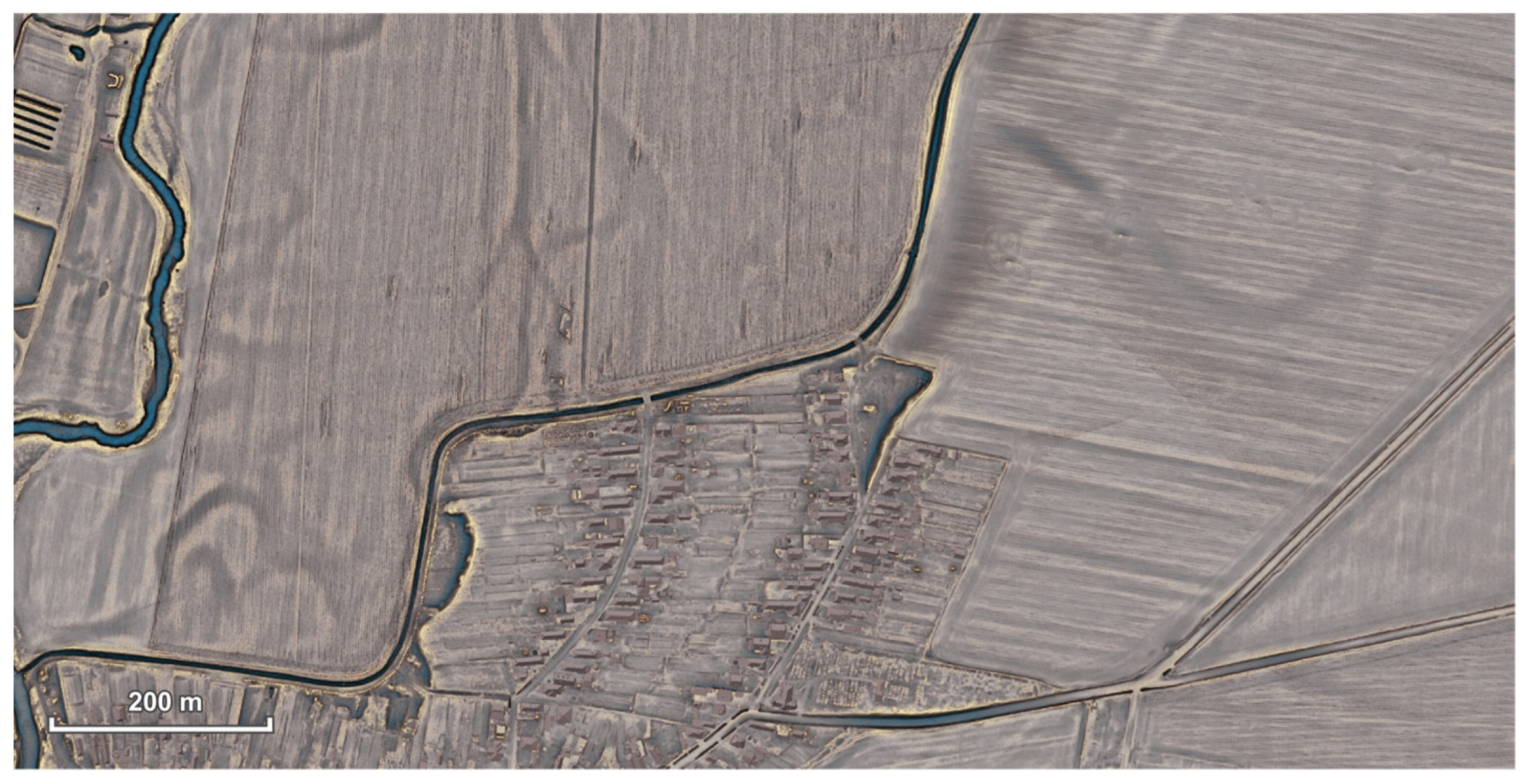


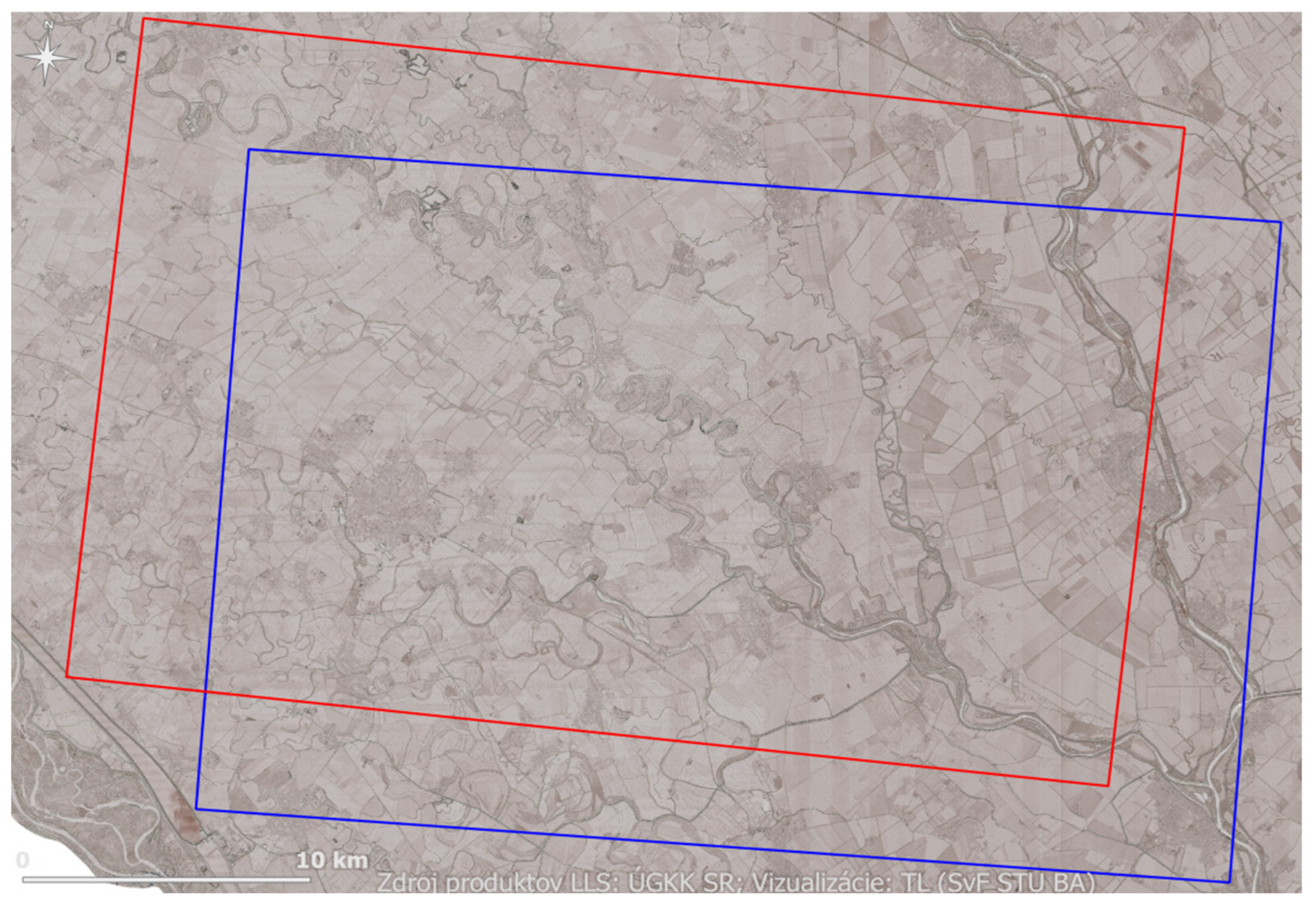
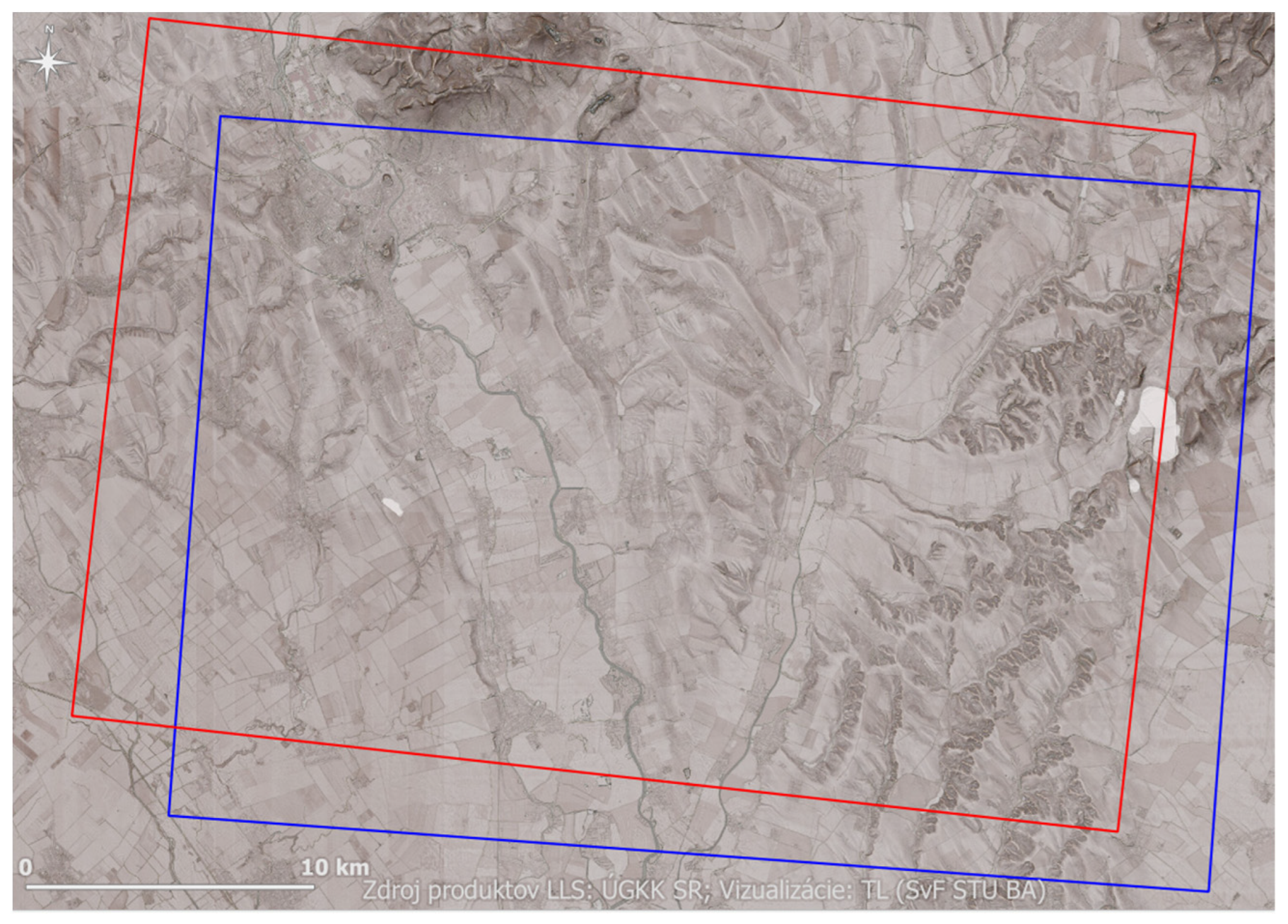


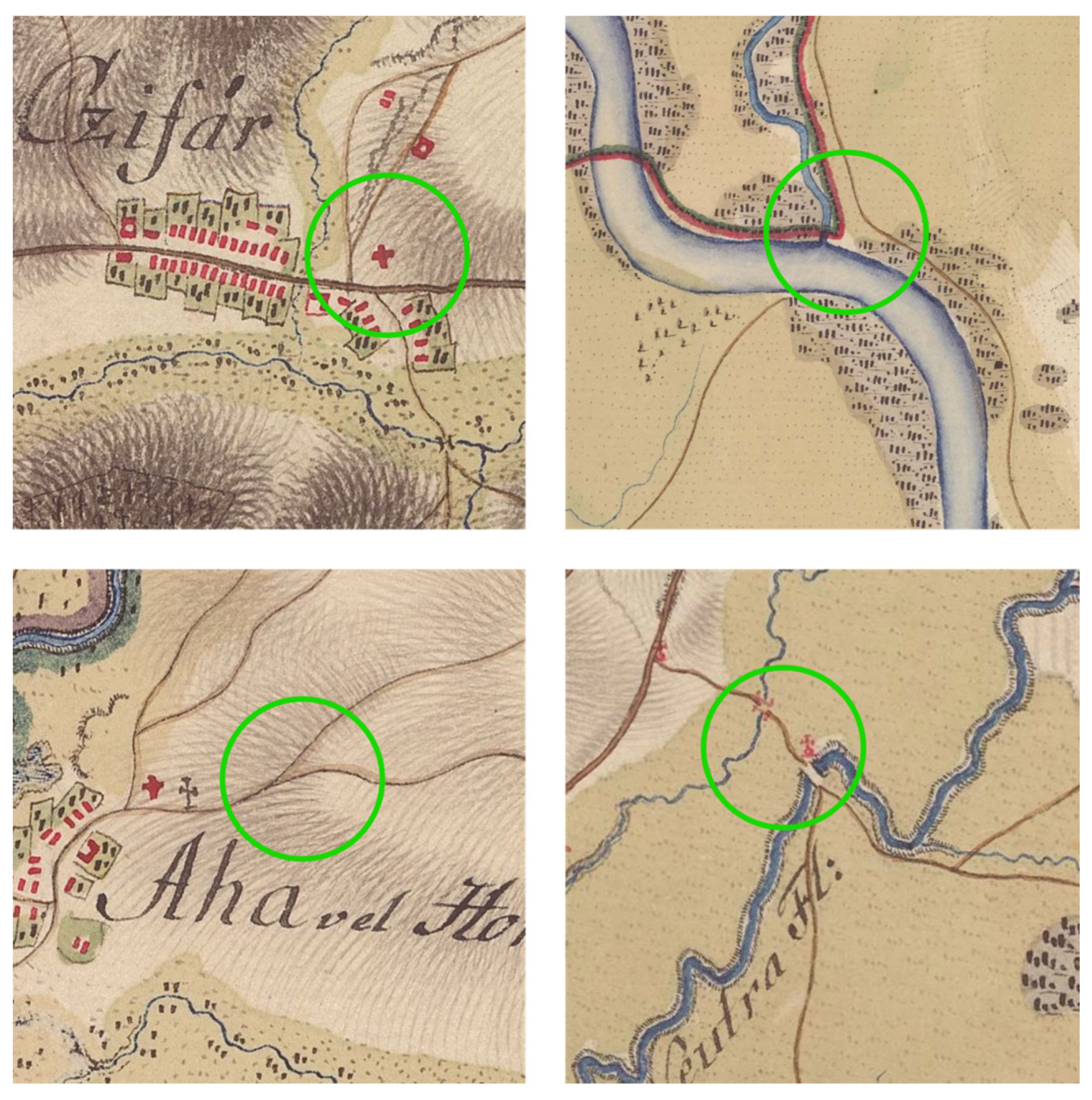

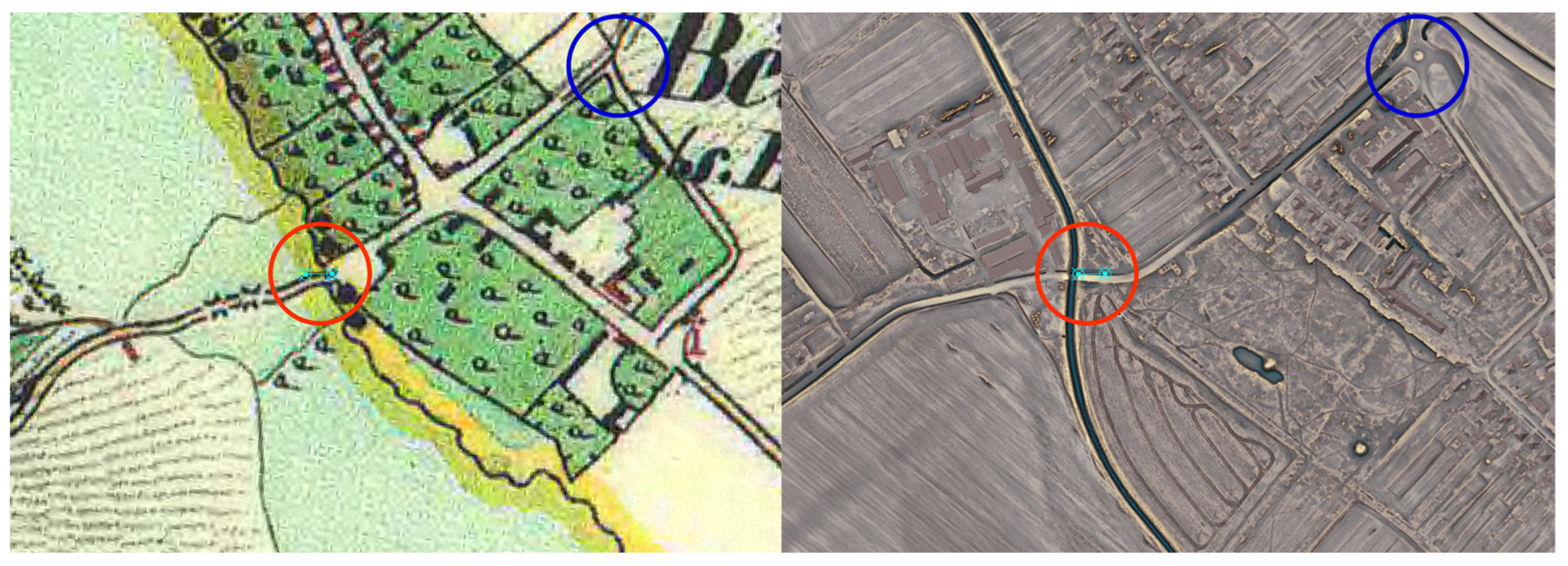
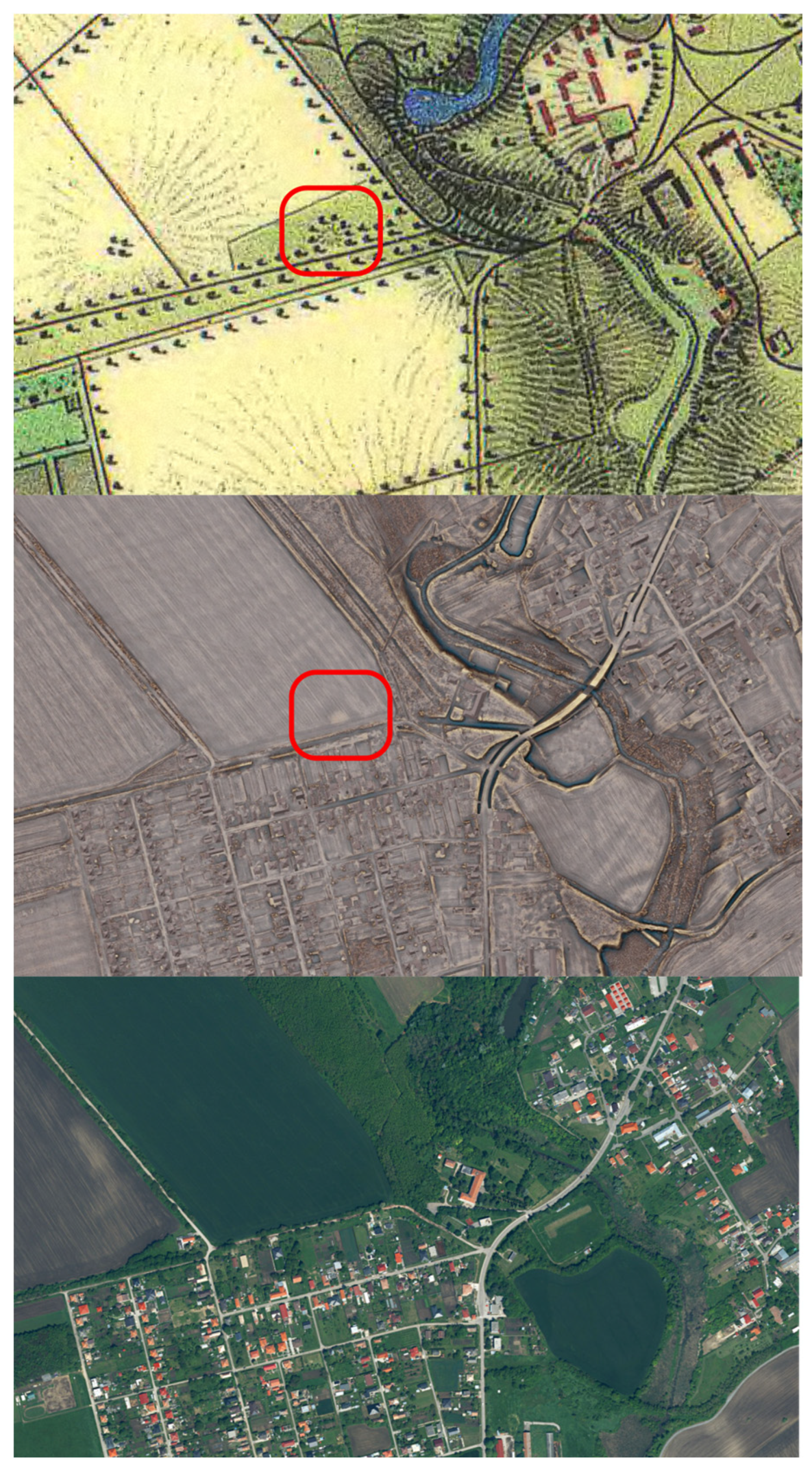
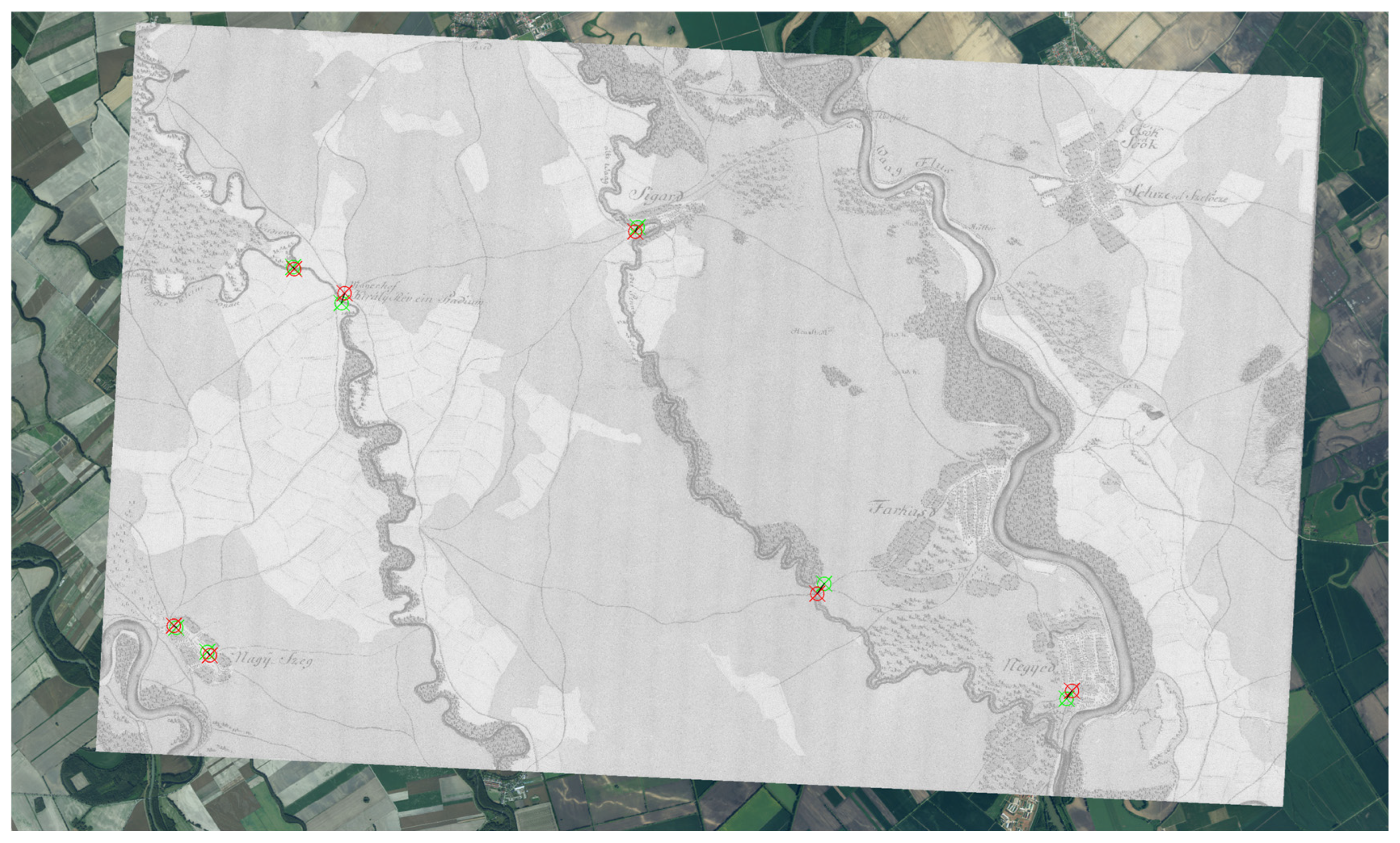
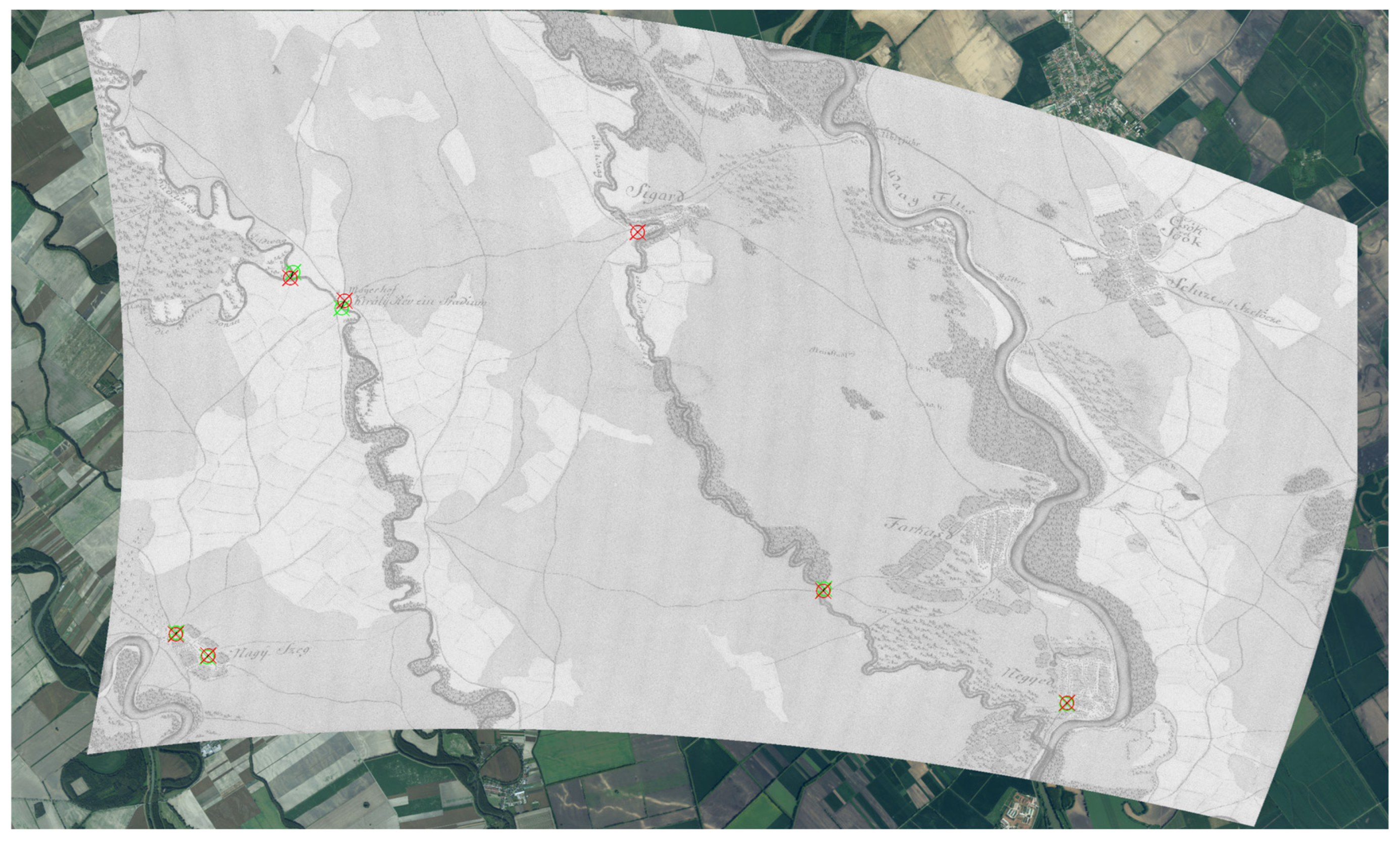

| Name | Historical Orthophoto Mosaic of Slovakia | Orthophoto Mosaic of the Slovak Republic | Special Maps 1:75,000 | Military Topographic Mapping 1:25,000 | Military Topographic Mapping 1:10,000 | Distance Map of Hungary 1:75,000 | Base Map of the Slovak Republic 1:10,000 | ALS Data |
|---|---|---|---|---|---|---|---|---|
| Year of issue | 1949 | 2019 | 1933 | 1957 | 1971 | 1903 | 2002 | 2023 |
| Reference system | S-JTSK (EPSG 5514) | S-JTSK (EPSG 5514) | S-JTSK (EPSG 5514) | S-52 (temporary military system derived from S-JTSK) | S-42 (EPSG 37257) | WGS 84 (EPSG 3857) | S-JTSK (EPSG 5514) | S-JTSK03 (EPSG 8353) |
| Scale | 1:5000 | N/A | 1:75,000 | 1:25,000 | 1:10,000 | 1:75,000 | 1:10,000 | N/A |
| Resolution | 0.50 m/pix | 0.25 m/pix | N/A | N/A | N/A | N/A | N/A | min. 5 pts/m2 |
| No. of map sheets | 10,201 | 10,278 | N/A | 670 | 1096 | N/A | 2818 | 42 |
| Format | WMS | WMS (TIF + TFW) | WMTS | WMTS | WMTS | WMS | WMS (TIF + TFW) | LAS |
| Provider | TUZVO | ÚGKK SR | ME SR | ME SR | ME SR | ÚGKK SR | ÚGKK SR | ÚGKK SR |
| First Military Survey | All Points | Filtered Points (Outliers Filtered with IQR) | |||||
|---|---|---|---|---|---|---|---|
| No. of pts. | Mean Distance [m] | Standard Deviation [m] | No. of pts. | Mean Distance [m] | Standard Deviation [m] | ||
| Lowlands | ARCANUM | 44 | 426.25 | 261.71 | 44 | 426.25 | 261.71 |
| SEA | 44 | 769.59 | 313.35 | 42 | 730.86 | 262.96 | |
| Undulating terrain | ARCANUM | 83 | 143.30 | 79.74 | 80 | 134.38 | 66.02 |
| SEA | 83 | 341.74 | 129.44 | 81 | 331.36 | 112.44 | |
| Low mountains | ARCANUM | 70 | 297.18 | 215.74 | 68 | 279.18 | 190.79 |
| SEA | 70 | 314.32 | 232.62 | 65 | 265.61 | 153.08 | |
| High mountains | ARCANUM | 45 | 287.78 | 231.37 | 42 | 239.49 | 146.71 |
| SEA | 45 | 952.14 | 236.32 | 45 | 952.14 | 236.32 | |
| First Military Survey | |||||
|---|---|---|---|---|---|
| Terrain | Point | Source | |||
| 1. | Undulating | 1. | Bridge | 1. | Orthophoto mosaic of the Slovak Republic |
| 2. | Low mountains | 2. | Church | 2. | Historical Orthophoto mosaic |
| 3. | High mountains | 3. | Crossroad | 3. | Base map of the Slovak Republic 1:10,000 |
| 4. | Lowlands | 4. | River confluence | 4. | Military topographic mapping (1:10,000; 1:25,000) |
| 5. | 5. | Special map of Hungary 1:75,000 | |||
| 6. | 6. | Distance map of Hungary 1:75,000 | |||
| Second Military Survey | All Points | Filtered Points (Outliers Filtered with IQR) | |||||
|---|---|---|---|---|---|---|---|
| No. of pts. | Mean Distance [m] | Standard Deviation [m] | No. of pts. | Mean Distance [m] | Standard Deviation [m] | ||
| Lowlands | ARCANUM | 92 | 87.85 | 38.56 | 92 | 87.85 | 38.56 |
| SEA | 92 | 57.28 | 55.34 | 87 | 52.75 | 22.80 | |
| Undulating terrain | ARCANUM | 113 | 46.84 | 25.64 | 108 | 43.32 | 20.02 |
| SEA | 113 | 53.06 | 25.07 | 113 | 53.06 | 25.07 | |
| Low mountains | ARCANUM | 99 | 37.16 | 24.31 | 95 | 33.82 | 16.95 |
| SEA | 99 | 57.62 | 33.11 | 96 | 53.79 | 23.44 | |
| High mountains | ARCANUM | 90 | 61.89 | 48.12 | 85 | 53.27 | 30.04 |
| SEA | 90 | 60.07 | 44.30 | 88 | 56.47 | 37.57 | |
| Second Military Survey | |||||
|---|---|---|---|---|---|
| Terrain | Point | Source | |||
| 1. | Undulating | 1. | Church | 1. | Orthophoto mosaic of the Slovak Republic |
| 2. | Low mountains | 2. | Bridge | 2. | Historical Orthophoto mosaic |
| 3. | Lowlands | 3. | Crossroad | 3. | Base map of the Slovak Republic 1:10,000 |
| 4. | High mountains | 4. | River confluence | 4. | Military topographic mapping (1:10,000; 1:25,000) |
| 5. | 5. | Special map of Hungary 1:75,000 | |||
| 6. | 6. | Distance map of Hungary 1:75,000 | |||
| Terrain | First Military Survey | Second Military Survey | ||||||
|---|---|---|---|---|---|---|---|---|
| Maps | ALS Data | Diff | In% | Maps | ALS Data | Diff | In% | |
| Together | 168 | 243 | 75 | 44.64% | 286 | 394 | 108 | 37.76% |
| Lowlands | 35 | 45 | 10 | 28.57% | 74 | 92 | 18 | 24.32% |
| Undulating terrain | 60 | 83 | 23 | 38.33% | 89 | 113 | 24 | 26.97% |
| Low mountains | 42 | 70 | 28 | 66.67% | 66 | 99 | 33 | 50.00% |
| High mountains | 31 | 45 | 14 | 45.16% | 57 | 90 | 33 | 57.89% |
| First Military Survey | Map Data | ALS Data | |||
|---|---|---|---|---|---|
| Area | Map Sheet | No. of pts. | Total Residuals [m] | No. of pts. | Total Residuals [m] |
| Lowlands | VIII-09 | 11 | 202.93 | 13 | 160.76 |
| VIII-10 | 10 | 60.89 | 15 | 46.49 | |
| IX-10 | 7 | 107.30 | 8 | 63.94 | |
| IX-11 | 7 | 111.71 | 9 | 88.44 | |
| Undulating terrain | X-10 | 14 | 103.64 | 18 | 84.35 |
| X-11 | 15 | 107.02 | 20 | 83.55 | |
| XI-12 | 17 | 131.54 | 23 | 79.35 | |
| XI-13 | 14 | 124.31 | 22 | 82.28 | |
| Low mountains | IX-03 | 10 | 297.95 | 14 | 140.04 |
| IX-04 | 10 | 168.05 | 22 | 121.97 | |
| X-05 | 9 | 204.21 | 18 | 186.84 | |
| X-06 | 13 | 153.09 | 16 | 92.93 | |
| High mountains | XVI-09 | 8 | 152.81 | 10 | 135.04 |
| XVI-10 | 8 | 176.58 | 11 | 108.49 | |
| XVII-09 | 7 | 121.82 | 11 | 118.89 | |
| XVII-10 | 8 | 93.92 | 13 | 80.19 | |
| Second Military Survey | Map Data | ALS Data | |||
|---|---|---|---|---|---|
| Area | Map Sheet | No. of pts. | Total Residuals [m] | No. of pts. | Total Residuals [m] |
| Lowlands | XXVI-45 | 19 | 33.96 | 21 | 28.25 |
| XXVI-46 | 23 | 43.31 | 29 | 26.15 | |
| XXVII-45 | 17 | 25.96 | 23 | 21.94 | |
| XXVII-46 | 15 | 42.94 | 19 | 29.58 | |
| Undulating terrain | XXVIII-43 | 26 | 30.96 | 33 | 22.42 |
| XXVIII-44 | 19 | 24.52 | 23 | 21.15 | |
| XXIX-43 | 23 | 29.08 | 30 | 22.08 | |
| XXIX-44 | 21 | 36.87 | 27 | 23.31 | |
| Low mountains | XXVII-39 | 14 | 55.03 | 23 | 27.22 |
| XXVII-40 | 18 | 26.28 | 27 | 23.94 | |
| XXVIII-39 | 15 | 31.11 | 27 | 24.42 | |
| XXVIII-40 | 19 | 32.12 | 22 | 39.26 | |
| High mountains | XXXIV-39 | 17 | 71.92 | 24 | 66.30 |
| XXXIV-40 | 13 | 37.10 | 25 | 36.56 | |
| XXXV-39 | 12 | 75.22 | 16 | 69.01 | |
| XXXV-40 | 15 | 65.80 | 25 | 39.29 | |
| First Military Survey | Map Data | ALS Data | |||
|---|---|---|---|---|---|
| Area | Map Sheet | No. of pts | Total Residuals [m] | No. of pts | Total Residuals [m] |
| Lowlands | VIII-09 | 11 | 138.93 | 13 | 90.65 |
| VIII-10 | 10 | 58.05 | 15 | 40.67 | |
| IX-10 | 7 | 59.82 | 8 | 31.09 | |
| IX-11 | 7 | 30.16 | 9 | 42.74 | |
| Undulating terrain | X-10 | 14 | 83.36 | 18 | 73.80 |
| X-11 | 15 | 91.87 | 20 | 83.55 | |
| XI-12 | 17 | 103.87 | 23 | 69.21 | |
| XI-13 | 14 | 79.79 | 22 | 66.89 | |
| Low mountains | IX-03 | 10 | 166.17 | 14 | 81.26 |
| IX-04 | 10 | 112.91 | 22 | 86.39 | |
| X-05 | 9 | 120.08 | 18 | 114.20 | |
| X-06 | 13 | 119.47 | 16 | 90.97 | |
| High mountains | XVI-09 | 8 | 64.56 | 10 | 85.56 |
| XVI-10 | 8 | 48.24 | 11 | 92.98 | |
| XVII-09 | 7 | 47.75 | 11 | 67.27 | |
| XVII-10 | 8 | 93.92 | 13 | 52.17 | |
| Second Military Survey | Map Data | ALS Data | |||
|---|---|---|---|---|---|
| Area | Map Sheet | No. of pts | Total Residuals [m] | No. of pts | Total Residuals [m] |
| Lowlands | XXVI-45 | 19 | 28.59 | 21 | 24.42 |
| XXVI-46 | 23 | 37.99 | 29 | 22.62 | |
| XXVII-45 | 17 | 19.96 | 23 | 21.90 | |
| XXVII-46 | 15 | 38.60 | 19 | 19.91 | |
| Undulating terrain | XXVIII-43 | 26 | 27.66 | 33 | 16.03 |
| XXVIII-44 | 19 | 18.51 | 23 | 15.59 | |
| XXIX-43 | 23 | 19.96 | 30 | 16.43 | |
| XXIX-44 | 21 | 36.87 | 27 | 17.31 | |
| Low mountains | XXVII-39 | 14 | 32.50 | 23 | 20.79 |
| XXVII-40 | 18 | 22.48 | 27 | 21.06 | |
| XXVIII-39 | 15 | 27.52 | 27 | 20.58 | |
| XVIII-40 | 19 | 26.86 | 22 | 22.75 | |
| High mountains | XXXIV-39 | 17 | 71.92 | 24 | 55.06 |
| XXXIV-40 | 13 | 27.22 | 25 | 21.51 | |
| XXXV-39 | 12 | 37.93 | 16 | 31.92 | |
| XXXV-40 | 15 | 52.38 | 25 | 36.51 | |
| Map Sheet | Terrain | No. of pts | Affine Transformation RMS [m] | Second-Degree Polynomial Transformation RMS [m] |
|---|---|---|---|---|
| 08-09 | Lowlands | 13 | 214.98 | 233.53 |
| 08-10 | Lowlands | 15 | 57.20 | 82.27 |
| 9-10 | Lowlands | 8 | 102.91 | 5822.06 |
| 09-11 | Lowlands | 9 | 137.94 | 167.07 |
| 10-10 | Undulating | 18 | 100.08 | 112.18 |
| 10-11 | Undulating | 20 | 115.66 | 114.70 |
| 11-12 | Undulating | 23 | 92.74 | 98.63 |
| 11-13 | Undulating | 22 | 99.22 | 104.16 |
| 09-03 | Low mountains | 14 | 193.70 | 211.34 |
| 09-04 | Low mountains | 22 | 151.81 | 125.58 |
| 10-05 | Low mountains | 18 | 232.17 | 190.43 |
| 10-06 | Low mountains | 16 | 115.20 | 164.83 |
| 16-09 | High mountains | 10 | 197.01 | 288.70 |
| 16-10 | High mountains | 11 | 155.16 | 557.22 |
| 17-09 | High mountains | 11 | 180.56 | 233.02 |
| 17-10 | High mountains | 13 | 104.21 | 114.32 |
| Map Sheet | Terrain | No. of pts | Affine Transformation RMS [m] | Second-Degree Polynomial Transformation RMS [m] |
|---|---|---|---|---|
| 26-45 | Lowlands | 21 | 33.33 | 40.16 |
| 26-46 | Lowlands | 29 | 29.28 | 28.17 |
| 27-45 | Lowlands | 23 | 25.86 | 32.35 |
| 27-46 | Lowlands | 19 | 35.47 | 30.54 |
| 28-43 | Undulating | 33 | 25.02 | 19.39 |
| 28-44 | Undulating | 23 | 24.80 | 21.13 |
| 29-43 | Undulating | 30 | 24.89 | 21.11 |
| 29-44 | Undulating | 27 | 26.62 | 21.94 |
| 27-39 | Low mountains | 23 | 31.99 | 30.53 |
| 27-40 | Low mountains | 27 | 27.21 | 31.10 |
| 28-39 | Low mountains | 27 | 28.25 | 25.60 |
| 28-40 | Low mountains | 22 | 47.87 | 35.22 |
| 34-39 | High mountains | 24 | 77.82 | 77.50 |
| 34-40 | High mountains | 25 | 45.52 | 32.22 |
| 35-39 | High mountains | 16 | 93.32 | 65.67 |
| 35-40 | High mountains | 25 | 44.07 | 48.96 |
Disclaimer/Publisher’s Note: The statements, opinions and data contained in all publications are solely those of the individual author(s) and contributor(s) and not of MDPI and/or the editor(s). MDPI and/or the editor(s) disclaim responsibility for any injury to people or property resulting from any ideas, methods, instructions or products referred to in the content. |
© 2025 by the authors. Published by MDPI on behalf of the International Society for Photogrammetry and Remote Sensing. Licensee MDPI, Basel, Switzerland. This article is an open access article distributed under the terms and conditions of the Creative Commons Attribution (CC BY) license (https://creativecommons.org/licenses/by/4.0/).
Share and Cite
Lieskovský, T.; Kotleba, T.; Šperka, J.; Ďuračiová, R. Airborne Lidar Refines Georeferencing Austro-Hungarian Maps from the First and Second Military Surveys. ISPRS Int. J. Geo-Inf. 2025, 14, 274. https://doi.org/10.3390/ijgi14070274
Lieskovský T, Kotleba T, Šperka J, Ďuračiová R. Airborne Lidar Refines Georeferencing Austro-Hungarian Maps from the First and Second Military Surveys. ISPRS International Journal of Geo-Information. 2025; 14(7):274. https://doi.org/10.3390/ijgi14070274
Chicago/Turabian StyleLieskovský, Tibor, Tadeáš Kotleba, Jakub Šperka, and Renata Ďuračiová. 2025. "Airborne Lidar Refines Georeferencing Austro-Hungarian Maps from the First and Second Military Surveys" ISPRS International Journal of Geo-Information 14, no. 7: 274. https://doi.org/10.3390/ijgi14070274
APA StyleLieskovský, T., Kotleba, T., Šperka, J., & Ďuračiová, R. (2025). Airborne Lidar Refines Georeferencing Austro-Hungarian Maps from the First and Second Military Surveys. ISPRS International Journal of Geo-Information, 14(7), 274. https://doi.org/10.3390/ijgi14070274






